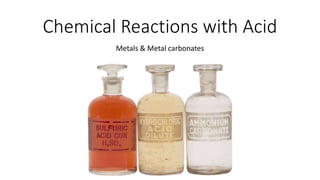
Chemical reactions with acids Year 10 science.pptx
- 1. Chemical Reactions with Acid Metals & Metal carbonates
- 2. What are acids? Today, many people use the Brønsted-Lowry definition of acids: a molecule that will give away a proton — also known as an hydrogen ion — from one of its hydrogen atoms. This tells us that all Brønsted-Lowry acids must contain hydrogen.
- 3. What are acids? • Acids have a sour taste. Lemons, vinegar, and sour candies all contain acids. • Acids have the ability to conduct electricity. Aqueous acidic solutions are used as strong electrolytes. • Acids are corrosive in nature. Should be handled with care otherwise, they can corrode our skin • Acidic fumes will burn your nose • Acids are mostly present in liquid or gaseous forms. But we do have solid acids like zeolitic materials. • Acids have a pH < 7 and are identified by shades of red and yellow color with universal indicator solution.
- 4. Reaction 1: Acids & Metals Acids react with some metals to produce a salt and hydrogen gas. Metal + acid → salt + hydrogen gas The abbreviation M.A.S.H. can be used to remember this general reaction.
- 5. Reaction 1: Acids & Metals When a metal is put in acid, it gets smaller and smaller as it gets used up in the chemical reaction. At the same time, bubbles of gas can be seen. The bubbles produced in the reaction are hydrogen gas. Example 1: Hydrochloric acid + Calcium Calcium chloride + Hydrogen gas HCl + Ca CaCl2 + H2
- 6. Reaction 1: Acids & Metals Example 2: Hydrochloric acid + Magnesium ___________ + ___________ HCl + Mg ________ + __________
- 7. Reaction 1: Acids & Metals Example 2: Hydrochloric acid + Magnesium Magnesium chloride + Hydrogen gas HCl + Mg MgCl2 + H2
- 8. Reaction 1: Acids & Metals The name of the salt formed from the reaction of a metal and acid can be worked out using the names of the metal and the acid. Name of metal + name of acid → salt name 1. The first word is the name of the metal For example, a salt made when magnesium is added to an acid would have magnesium as its first word. 2. The second word of the name is taken from the name of the acid Hydrochloric acid → chloride Nitric acid → nitrate Sulfuric acid → sulfate
- 9. Reaction 2: Acids & Metal carbonates Acids react with metal carbonates or metal (hydrogen) bicarbonates to give out carbon dioxide, metal salts and water. Acid + Metal carbonate → Salt + Water + Carbon dioxide The carbon dioxide causes bubbling during the reaction, which is observed as fizzing. It can be detected by passing the gas through limewater, which will go cloudy. Also, the reaction of metal carbonates with acids is exothermic (ie heat energy is given out).
- 10. Reaction 2: Acids & Metal carbonates Example: Sulfuric acid + Calcium carbonate Calcium sulfate + Water + Carbon dioxide H2SO4 + CaCO3 CaSO4 + H2O + CO 2
- 11. Identifying the products of chemical reactions
- 12. Identifying the products of chemical reactions
- 13. Acid Rain Acid rain describes any form of precipitation that contains high levels of nitric and sulfuric acids, caused by the air pollution of gaseous nitrogen and sulfur oxides released by industrial activity. In addition to environmental harm to forests, rivers and lakes, acid rain heavily impacts man made structures created from metal, sandstone and marble.
- 14. Neutralisation is a chemical reaction between an acid and alkali to form a salt and water. Acid + alkali Salt + Water. A salt is an ionic compound that is electrically neutral. Reaction 3: Acids & Bases (Neutralisation)
- 15. Base vs Alkali All alkalis are bases, but only soluble bases are also alkalis
- 17. Common Properties and Uses of Acids pH < 7 Corrosive Sour taste Turns blue litmus paper red Acids are proton (H+) donors Common acids in schools are: HCl = Hydrochloric acid H2SO4 = Sulfuric acid HNO3 = Nitric acid
- 18. Vinegar Ethanoic acid Fizzy drinks Carbonic acid Tea Tannic acid Vitamin C Ascorbic acid Lemons Citric acid
- 19. Common Properties and Uses of Bases/Alkali pH > 7 Caustic (burn/corrode) Feels soapy Bitter taste Turns red litmus paper blue Acids are proton (H+) acceptors Common acids in schools are: NaOH = Sodium hydroxide NH4OH = Ammonium hydroxide Ca(OH)2 = Calcium hydroxide
- 21. Endothermic vs Exothermic? Energy is stored within chemical bonds. During chemical reactions, old chemical bonds (in the reactant) are broken and new chemical bonds (in the product) are created. Energy is transferred during chemical reactions. Reactions that produce heat (energy) and transfer it to their surroundings are called exothermic reactions. Reactions that absorb energy from their surroundings are called endothermic reactions.
- 22. Is Neutralisation Endothermic or Exothermic?
Editor's Notes
- Insight work book45
- To identify if the neutralisation reaction between an acid and base is exothermic or endothermic.